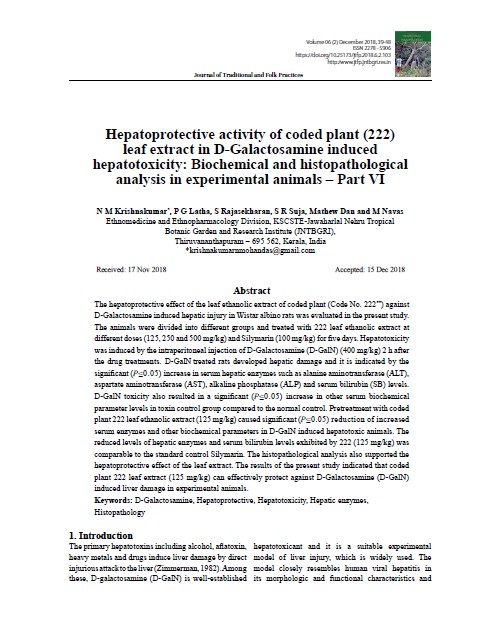Hepatoprotective activity of coded plant (222) leaf extract in D-Galactosamine induced hepatotoxicity: Biochemical and histopathological analysis in experimental animals – Part VI
Keywords:
D-Galactosamine, Hepatoprotective, Hepatotoxicity, Hepatic enzymes, HistopathologyAbstract
The hepatoprotective effect of the leaf ethanolic extract of coded plant (Code No. 222**) against D-Galactosamine induced hepatic injury in Wistar albino rats was evaluated in the present study. The animals were divided into different groups and treated with 222 leaf ethanolic extract at different doses (125, 250 and 500 mg/kg) and Silymarin (100 mg/kg) for five days. Hepatotoxicity was induced by the intraperitoneal injection of D-Galactosamine (D-GalN) (400 mg/kg) 2 h after the drug treatments. D-GalN treated rats developed hepatic damage and it is indicated by the significant (P≤0.05) increase in serum hepatic enzymes such as alanine aminotransferase (ALT), aspartate aminotransferase (AST), alkaline phosphatase (ALP) and serum bilirubin (SB) levels. D-GalN toxicity also resulted in a significant (P≤0.05) increase in other serum biochemical parameter levels in toxin control group compared to the normal control. Pretreatment with coded plant 222 leaf ethanolic extract (125 mg/kg) caused significant (P≤0.05) reduction of increased serum enzymes and other biochemical parameters in D-GalN induced hepatotoxic animals. The reduced levels of hepatic enzymes and serum bilirubin levels exhibited by 222 (125 mg/kg) was comparable to the standard control Silymarin. The histopathological analysis also supported the hepatoprotective effect of the leaf extract. The results of the present study indicated that coded plant 222 leaf extract (125 mg/kg) can effectively protect against D-Galactosamine (D-GalN) induced liver damage in experimental animals.


